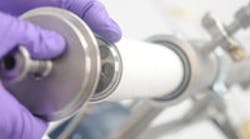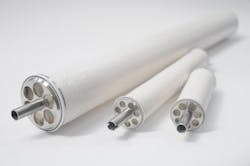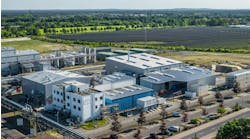Organic solvent nanofiltration (OSN) is starting to carve out a role in a number of process applications, including polymeric impurity removal, monomer/dimer separation, catalyst recovery and recycle, and color elimination. The technology requires less than 10% of the energy needed by thermal separation techniques such as distillation, and can provide ultrapure products and help increase product yield.
At the forefront of OSN developments is Evonik Industries, Essen, Germany. Its efforts really took off in March 2010 with the acquisition of Membrane Extraction Technology (MET), London, U.K. — a company spun off in 1996 by the department of chemical engineering at Imperial College London that boasts a range of proprietary technologies and offers DuraMem OSN membranes.
Andrew Livingston, Evonik MET's chief innovation officer and head of the department of chemical engineering at Imperial College, estimates the U.S. process industries alone could save between 3 and 5% in energy costs if membranes were used to extract organic solvents.
The DuraMem membranes reportedly offer long-term stability in polar solvents, including aggressive ones such as those in the polar aprotic family — for example, acetone, tetrahydrofuran and dimethylformamide. The molecular cut-off range is 150–900 Da, while maximum recommended temperature is 50°C and typical operating pressure is 20–40 bar. The membrane comes in two formats: flat sheets for lab trials, and spiral-wound modules for pilot trials and production.
Figure 1. Second-generation product suits a variety of solvents and apolar high boilers. Source: Evonik.
Figure 2. Tests of such modules in a small pilot unit establish rejection and flux performance. Source: Evonik.
Then, a mini-module of the selected membrane usually is installed in a small pilot unit to establish both rejection and flux performance (Figure 2). The data collected enable adjustment of process parameters such as flow rate, pressure and temperature for full process optimization. "At this stage, we are able to make an economic assessment as to whether a process is economically viable," notes Bouwhuis. "As a rule of thumb, we consider a process to be viable when the payback time is equal to or less than one year."These steps can be done either at the customer's site or at one of Evonik's regional labs in Europe, North America and Asia. If using OSN makes economic sense, Evonik then usually partners with an industry-specific OEM, or a customer's preferred OEM, to design a suitable plant for the particular application.BROADENING THE APPEALOSN isn't the holy grail of separation, Bouwhuis stresses. "Can we separate a solvent from a solvent at the moment? No. Is this a typical modular plug-and-play solution? No. It really is a lot more complex than plugging a cartridge in. The company's new app, which will shortly be launched under HP Polymers, will include a decision tree so that prospective customers can determine if OSN can work as an enabling technology for them."Combining OSN with existing conventional molecular separation techniques may lead to wider acceptance, he believes. "Seeing OSN as a process efficiency tool rather than a standalone technology is what we actively support for future prospects as we see the best use of the technology in optimizing production costs and increasing yield."Such optimizations could include: product stream polishing pre-chromatography/pre-crystallization; product concentration post-chromatography; product concentration pre-distillation; and solvent recycling post-chromatography.Meanwhile, research work continues. Livingston's group at Imperial College is probing several areas that may give clues as to where the future of OSN could lie — and how mainstream the techology could become.For example, one key area covers materials synthesis, membrane formation and membrane characterization. Here, the focus is on developing new OSN membranes — both polymeric and ceramic — and comparing their performance with commercially available materials. The researchers also are looking at the design and fabrication of membrane modules.Another area of research is to identify applications where OSN can replace energy-intensive distillation processes and complex solvent workups. In particular, this involves catalyst recycling, integration of reaction and separation in membrane reactors, and improved solvent operations such as solvent exchanges and fractionation. Researchers are creating novel separation flowsheets and developing continuous membrane processes as alternatives to traditional distillation and chromatography separations.A third area focuses on improving the understanding of how high-performance aromatic-heterocyclic-polymer-based membranes could serve in OSN applications. Such membranes potentially could be used in harsh environments such as those posed by strong acids and strong bases; research on extending their application to a range of solvents is underway. Another strand of work is looking at next-generation drugs based on biomolecules such as peptides and oligonucleotides. Today, their manufacture is based on solid-phase synthesis and involves cumbersome separations. This project focuses on developing new manufacturing routes to improve the separation processes central to their synthesis — and integrating them with reaction processes.Finally, there's OSN crystallization, which uses solvent-resistant nanofiltration membrane technology to enhance crystallization of organic compounds. OSN crystallization has the potential to reduce energy or chemical inputs and allow tighter control of process conditions, improving crystal parameters. Investigations into OSN crystallization so far have explored using membranes to control crystal size, shape and polymorphism.ANOTHER CONTENDERMeanwhile, Sulzer Chemtech, Allschwil, Switzerland, is active in developing applications for OSN, which it also calls solvent-resistant nanofiltration, notes Corrie Korink-Zoetekouw, manager business development, process technology. The company says the technology can be applied as a standalone solution or combined with conventional separation technologies such as distillation, evaporation, chromatography and crystallization in a hybrid solution. Benefits include a reduction in the energy needed for separation processes, plus improved product quality and yield. Sulzer foresees applications in any processing situation where gentle product conditions can improve product quality.




